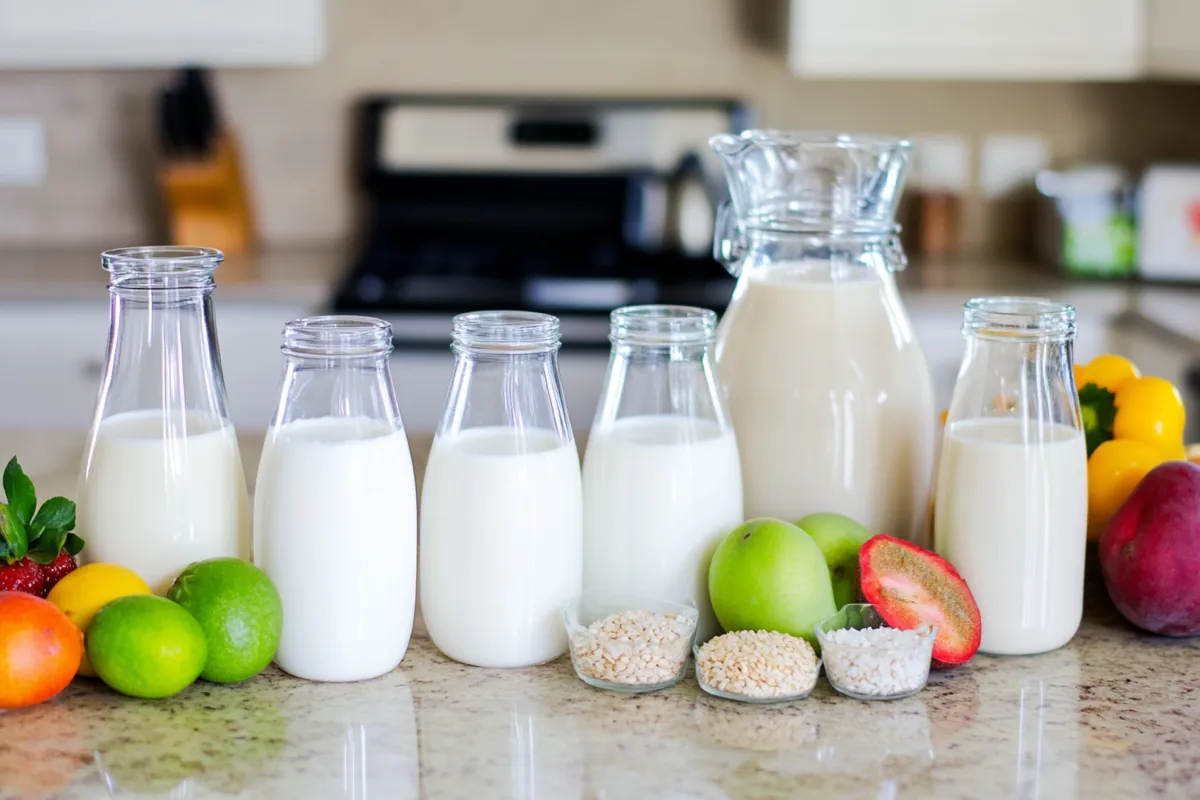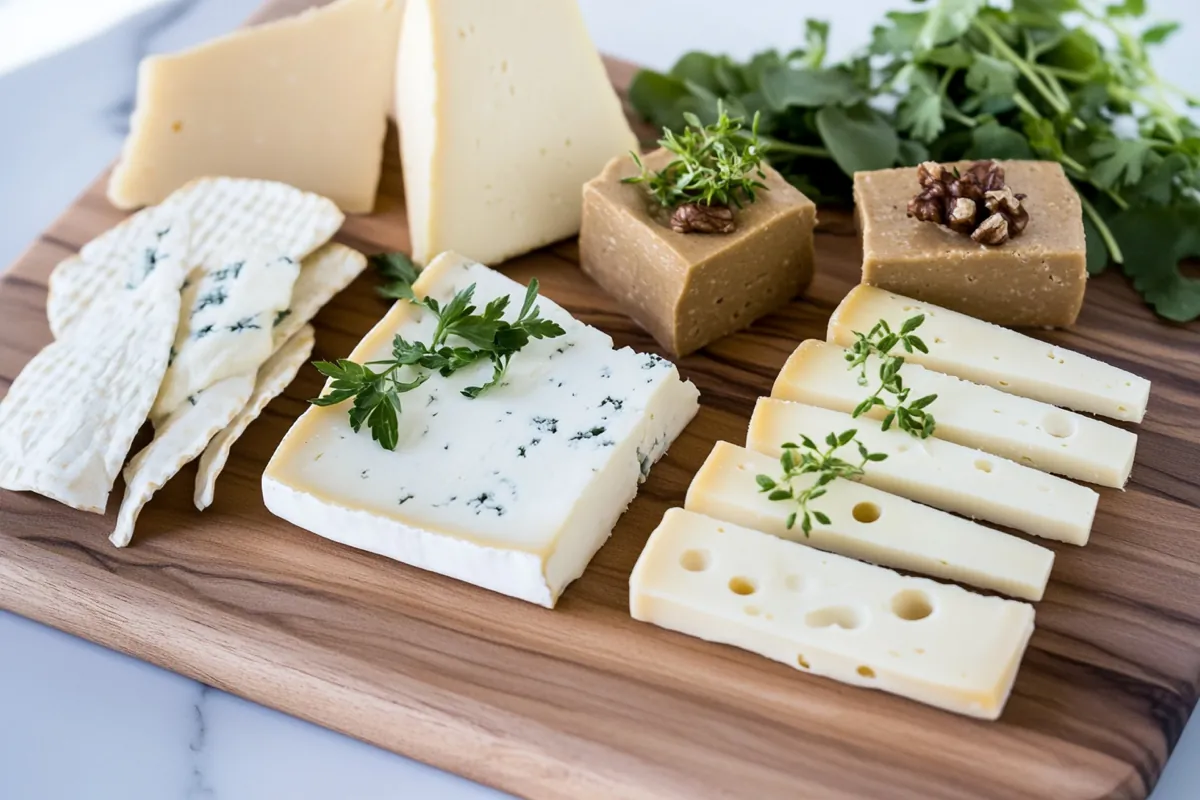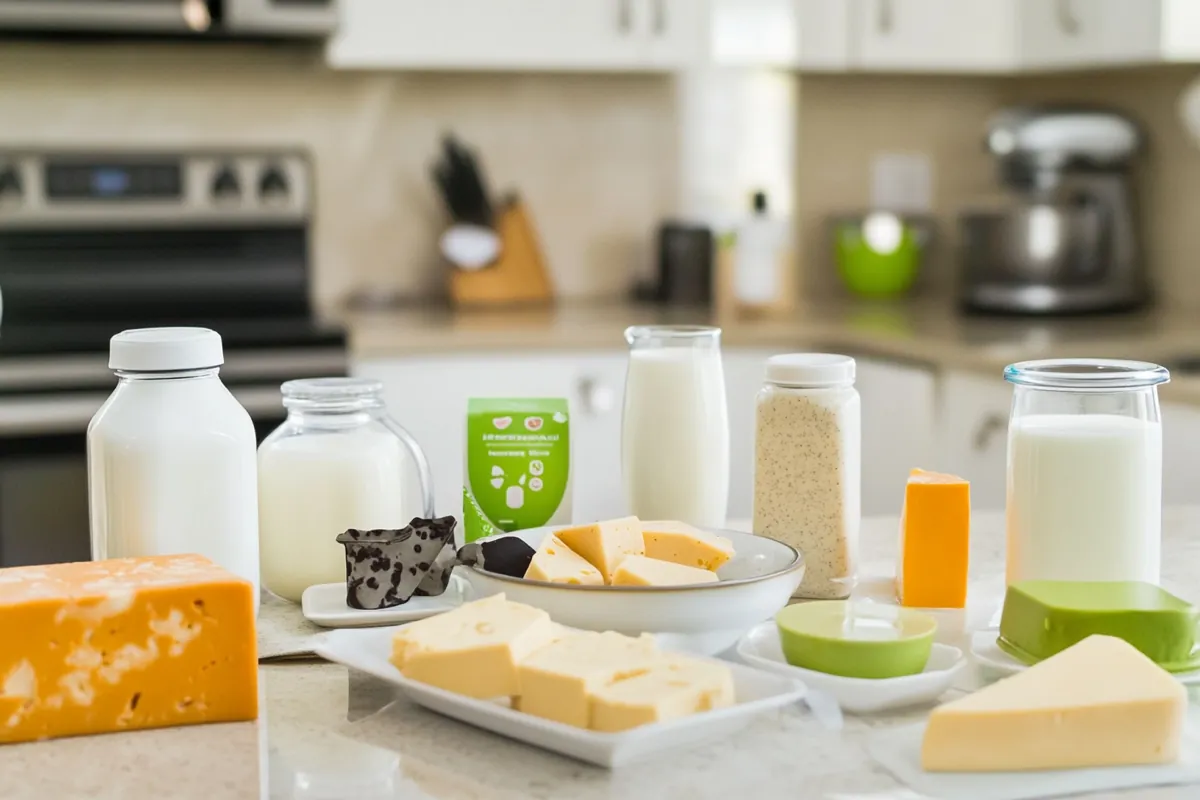In recent years, many people have started exploring dairy and ingredient alternatives for various reasons, including health, ethical concerns, and dietary restrictions. This guide dives into the world of dairy substitutes, explaining what they are, their importance, and offering practical options. You will learn about dairy-free alternatives to milk, as well as options for cheese and other dairy products. Understanding these alternatives can help you make informed dietary choices.
Table of Contents
Understanding Dairy and Alternatives
The concept of dairy alternatives encompasses a variety of products designed to replace traditional dairy items. These alternatives often come from plant-based sources, although there are also non-dairy options made from nuts and grains. They serve as substitutes for milk, cheese, yogurt, and other dairy products.
What Are Dairy and Alternatives?
Dairy alternatives are products that mimic the taste and texture of traditional dairy foods but do not contain animal-derived ingredients. Common examples include almond milk, soy yogurt, and coconut cream. These alternatives are popular among vegans, lactose-intolerant individuals, and those with dairy allergies. They can also be lower in calories and saturated fat compared to their dairy counterparts.
Importance of Dairy and Ingredient Alternatives
Using dairy and ingredient alternatives is important for several reasons. First, they provide options for people with dietary restrictions who may not be able to consume traditional dairy. Secondly, many of these alternatives are fortified with vitamins and minerals, making them nutritionally beneficial. Lastly, choosing plant-based products can have a positive impact on the environment, as they typically require fewer resources to produce than dairy from animals.
Dairy-Free Alternatives to Milk
The market for dairy-free alternatives to milk has expanded dramatically. There are now numerous options available that cater to different tastes and nutritional needs. Below, we explore several popular dairy-free milk alternatives.
Overview of Dairy-Free Milk Options
Dairy-free milk options are primarily made from plants, nuts, or grains. Each type offers unique flavors and textures, making them suitable for various culinary applications. Whether you’re using them for cooking, baking, or simply enjoying a glass, these alternatives can enhance your meals.
Almond Milk: Benefits and Uses
Almond milk is a popular choice among those seeking a lighter alternative to cow’s milk. It is low in calories and often fortified with vitamins like calcium and vitamin D. Almond milk works well in smoothies, cereals, and baking.
Soy Milk: Nutritional Profile
Soy milk is one of the most nutritionally comparable alternatives to cow’s milk. It contains protein similar to that of dairy and is also rich in calcium. Soy milk can be used in cooking and baking or enjoyed in coffee and tea.
Oat Milk: Rising Popularity and Uses
Oat milk has gained popularity for its creamy texture and natural sweetness. It is an excellent choice for coffee drinks and smoothies. Additionally, it’s often fortified with vitamins and minerals and is a good option for those with nut allergies.
Coconut Milk: Culinary Uses and Benefits
Coconut milk provides a rich and creamy texture, making it ideal for cooking and baking. It adds a unique flavor to dishes, particularly in Asian cuisines. Coconut milk is also high in healthy fats, which can be beneficial in moderation.
Rice Milk: A Gentle Alternative
Rice milk is one of the mildest dairy alternatives available, making it suitable for those with allergies to soy or nuts. It is often fortified with vitamins and minerals and can be used in various recipes, including desserts and cereals.

Dairy Alternatives for Cheese
The demand for dairy alternatives for cheese has surged as more people seek out plant-based diets or have dairy intolerances. These alternatives not only provide similar flavors and textures but also cater to a wide range of dietary preferences. In this section, we explore various types of dairy alternatives for cheese and offer tips on how to use them in your culinary creations.
Types of Dairy Alternatives for Cheese
There are several types of dairy alternatives designed to replace cheese in a variety of dishes. Each option has unique characteristics that can complement different recipes.
Nut-Based Cheeses: Cashew and Almond Options
Nut-based cheeses are among the most popular dairy-free cheese alternatives. Cashew cheese, for example, is creamy and rich, making it perfect for spreads or sauces. Almond cheese often has a slightly firmer texture, which can be sliced or grated. Both options are typically made by soaking nuts and blending them with seasonings, yielding a product that is both flavorful and nutritious. You can easily find recipes for homemade nut cheeses online or purchase them pre-made at health food stores.
Soy and Tofu Cheeses: Versatile Choices
Soy and tofu cheeses are excellent options for those looking for a protein-rich alternative. Tofu can be blended with nutritional yeast, spices, and herbs to create a creamy cheese spread or a ricotta-style filling. Soy cheese products are widely available and often melt well, making them suitable for pizzas and casseroles. Their versatility allows them to be incorporated into a variety of dishes, enhancing both flavor and texture.
Coconut and Other Plant-Based Cheese Alternatives
Coconut cheese alternatives often have a unique texture and flavor profile, making them ideal for cooking and baking. These products can include coconut oil, which contributes to a creamy consistency. Other plant-based cheeses may be made from ingredients like tapioca or potato starch, offering a variety of textures and flavors. These options can be used in everything from quesadillas to creamy pasta dishes, providing a satisfying alternative to traditional cheese.
How to Use Dairy Alternatives in Cheese Recipes
Utilizing dairy alternatives for cheese can open up a world of culinary possibilities. Here are some tips for incorporating these products into your cooking.
Cooking and Melting Characteristics
When using dairy alternatives in recipes, it’s essential to understand their melting characteristics. Some cheese alternatives melt beautifully, while others may not. For instance, soy cheese tends to melt well, making it great for pizzas, whereas nut-based cheeses may be better suited for dips and spreads. Experimenting with different brands and types can help you find the perfect match for your dishes.
Flavor Pairing Tips for Dairy-Free Cheeses
Pairing flavors correctly can elevate your dishes when using dairy-free cheeses. For example, nut-based cheeses often pair well with herbs like basil and oregano, while soy cheeses can complement spicy or savory flavors. Additionally, don’t hesitate to experiment with different spices and condiments to enhance the flavor profiles of your dairy alternatives.
By understanding the variety of dairy alternatives for cheese available and learning how to use them effectively, you can create delicious and satisfying meals without the need for traditional dairy products.

Dairy and Alternatives Examples
In the evolving landscape of nutrition, dairy and alternatives examples are essential for anyone looking to diversify their diet. This section highlights popular dairy alternatives, their health benefits, and innovative ways to use them in various recipes. By understanding these alternatives, you can make informed choices that fit your lifestyle and dietary needs.
Popular Dairy Alternatives in the Market
There are several dairy alternatives available today, each catering to different tastes and nutritional needs. Here are some of the most popular options:
Overview of Leading Brands
Many brands have emerged to provide consumers with quality dairy alternatives. Some notable brands include:
- Almond Breeze: Known for its almond milk, this brand offers a variety of flavors, including sweetened and unsweetened options.
- Silk: Specializes in soy milk and other plant-based products, such as yogurt and creamers, offering a wide range of choices for consumers.
- Daiya: Renowned for its dairy-free cheese products, Daiya provides options that melt and stretch, making them ideal for cooking.
- Oatly: Famous for its oat milk, Oatly has gained popularity for its creamy texture and versatility in coffee and cooking.
These brands often fortify their products with vitamins and minerals, making them a nutritious choice for those seeking dairy alternatives.
Health and Nutritional Comparisons
When comparing dairy alternatives, it’s essential to consider their nutritional content. Here’s a quick comparison of some common dairy substitutes:
| Dairy Alternative | Calories (per cup) | Protein (grams) | Calcium (mg) |
|---|---|---|---|
| Almond Milk | 30 | 1 | 450 |
| Soy Milk | 80 | 7 | 300 |
| Oat Milk | 60 | 2 | 350 |
| Coconut Milk | 45 | 0 | 0 |
| Rice Milk | 50 | 1 | 200 |
As you can see, soy milk is a strong contender in terms of protein content, making it an excellent option for those looking to boost their intake. Almond milk, while lower in calories, provides a good source of calcium when fortified. It’s important to read labels and choose products that align with your health goals.
Creative Uses of Dairy Alternatives in Recipes
Dairy alternatives can be used in a wide variety of recipes, allowing you to enjoy your favorite dishes without traditional dairy. Here are some creative uses for these alternatives:
Baking and Cooking with Dairy-Free Ingredients
Incorporating dairy-free ingredients into baking can yield delicious results. For instance:
- Dairy-Free Pancakes: Substitute cow’s milk with almond or oat milk for fluffy pancakes that everyone can enjoy.
- Vegan Mac and Cheese: Use cashew cheese or nutritional yeast for a creamy and cheesy flavor without the dairy.
- Creamy Soups: Coconut milk can add richness to soups, such as butternut squash or tomato basil, enhancing flavor and texture.
Experimenting with different alternatives can lead to delightful surprises in your cooking.
Dairy-Free Snacks and Desserts
Dairy alternatives are also fantastic for creating snacks and desserts. Consider these options:
- Yogurt Parfaits: Layer coconut yogurt with granola and fresh fruit for a refreshing breakfast or snack.
- Chia Pudding: Use almond milk to create a simple and nutritious chia pudding, topped with berries and nuts.
- Ice Cream Substitutes: Many brands offer dairy-free ice creams made from coconut or almond milk, providing a sweet treat without dairy.
These creative uses highlight the versatility of dairy alternatives, making it easy to enjoy your favorite foods without dairy.
Now that we’ve covered various dairy and alternatives examples, it’s clear that there are numerous options available to satisfy different tastes and dietary needs. Understanding these alternatives can help you create delicious meals while adhering to your dietary preferences.

What Happens to Your Body When You Cut Out Dairy
Deciding to eliminate dairy from your diet can significantly impact your health and well-being. Many people choose to go dairy-free for various reasons, including lactose intolerance, allergies, or personal preferences. Understanding the effects of cutting out dairy can help you make informed decisions about your dietary choices.
Potential Health Benefits of Going Dairy-Free
Improved Digestion: Many individuals find that removing dairy improves their digestive health. For those who are lactose intolerant, eliminating dairy can prevent uncomfortable symptoms like bloating, gas, and diarrhea. Moreover, switching to plant-based alternatives often increases fiber intake, promoting better gut health.
Clearer Skin: Some people notice an improvement in their skin condition after eliminating dairy. Studies suggest that dairy may contribute to acne in some individuals, possibly due to hormones present in milk. By going dairy-free, you may experience fewer breakouts and a clearer complexion.
Increased Energy Levels: Some individuals report feeling more energetic when they cut out dairy. This could be due to a decrease in inflammation, as dairy can be inflammatory for some people. As a result, they may feel less sluggish and more vibrant.
Weight Management: Dairy alternatives often have lower calories and saturated fat content than traditional dairy products. For those looking to manage their weight, incorporating more plant-based options may assist in achieving their goals.
Possible Nutritional Deficiencies to Consider
While there are many benefits to going dairy-free, it’s essential to be aware of potential nutritional deficiencies that can arise:
Calcium: Dairy is a well-known source of calcium, crucial for bone health. When eliminating dairy, it’s vital to replace calcium sources with alternatives such as fortified plant-based milk, leafy greens, tofu, and nuts.
Vitamin D: Many dairy products are fortified with vitamin D, which aids calcium absorption. Ensure you get enough vitamin D from sunlight exposure or consider fortified dairy alternatives and supplements if necessary.
Protein: Dairy is a significant source of protein, especially for those who consume it regularly. Transitioning to dairy alternatives may require conscious planning to ensure you maintain adequate protein intake through options like soy products, legumes, and nuts.
Vitamin B12: Dairy products are a source of vitamin B12, primarily found in animal-based foods. If you’re going dairy-free and following a vegan diet, consider fortified foods or supplements to meet your B12 needs.
FAQ
What is the Best Dairy Alternative?
The “best” dairy alternative depends on individual preferences and dietary needs. Soy milk is often considered one of the best options due to its protein content and versatility. However, others may prefer almond or oat milk for their flavor and texture.
What Are Other Names for Dairy in Ingredients?
Dairy can be listed under various names in ingredient lists, such as whey, casein, lactose, and curds. Being aware of these terms is essential for those avoiding dairy products.
Can Dairy Alternatives Support a Balanced Diet?
Yes, dairy alternatives can support a balanced diet when chosen wisely. Opt for fortified products to ensure adequate intake of essential nutrients like calcium and vitamin D. Incorporating a variety of plant-based foods can help maintain overall nutritional balance.
Are Dairy-Free Alternatives Suitable for Everyone?
While many people enjoy dairy-free alternatives, they may not be suitable for everyone. Individuals with specific allergies to nuts or soy should be cautious when selecting alternatives. Always consult with a healthcare provider or nutritionist if you’re unsure about your dietary choices.
How to Transition to Dairy Alternatives Smoothly?
Transitioning to dairy alternatives can be made easier by gradually replacing dairy products with their alternatives. Start with one type of dairy product at a time, experimenting with different brands and flavors to find what you like best. Incorporating these alternatives into familiar recipes can also help ease the transition.
By understanding the effects of cutting out dairy and exploring dairy and ingredient alternatives, you can make informed choices that align with your health goals and dietary preferences.




